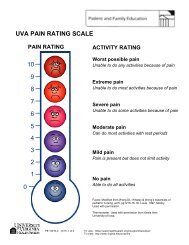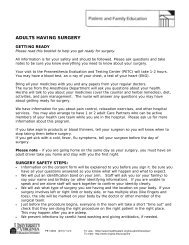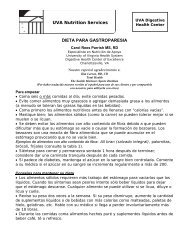about Mohs surgery - University of Virginia Health System
about Mohs surgery - University of Virginia Health System
about Mohs surgery - University of Virginia Health System
Create successful ePaper yourself
Turn your PDF publications into a flip-book with our unique Google optimized e-Paper software.
GUIDE TO MOHS MICROGRAPHIC SURGERY<br />
WHAT IS MOHS SURGERY?<br />
<strong>Mohs</strong> micrographic <strong>surgery</strong> is a method <strong>of</strong> skin<br />
cancer removal that results in low recurrence<br />
rates and maximum preservation <strong>of</strong> normal surrounding<br />
tissue. The technique was developed by<br />
Dr. Frederic <strong>Mohs</strong> in the 1930’s, and has been<br />
refined over the years. It is widely accepted as a<br />
highly effective method <strong>of</strong> treating certain types<br />
<strong>of</strong> skin cancers.<br />
WHAT IS SKIN CANCER?<br />
Cancer consists <strong>of</strong> cells growing at an irregular,<br />
unpredictable, and uncontrollable rate. Skin cancer<br />
is the most common form <strong>of</strong> cancer in humans.<br />
Each year, over one million people will<br />
develop skin cancer in the United States. If left<br />
untreated, skin cancer will continue to grow and<br />
could destroy healthy surrounding tissue and may<br />
even spread to other parts <strong>of</strong> the body. While<br />
there are many types <strong>of</strong> skin cancer, the most<br />
common forms are basal cell carcinoma, squamous<br />
cell carcinoma, and melanoma. Actinic keratosis<br />
is a form <strong>of</strong> precancer and has the potential<br />
<strong>of</strong> becoming a skin cancer.<br />
WHAT TREATMENTS ARE AVAILABLE FOR<br />
SKIN CANCER?<br />
There are several methods available for treating<br />
skin cancer. The chosen method will depend on<br />
the type, size, and location <strong>of</strong> the skin cancer,<br />
and whether it has been treated previously. The<br />
patient’s age and health may also influence the<br />
chosen treatment. Your physician can discuss the<br />
various treatment alternatives with you.<br />
Treatment methods available include:<br />
1. Curettage and dessication – scraping and<br />
burning the affected tissue<br />
2. Cryo<strong>surgery</strong> – freezing the affected tissue<br />
3. Topical or intralesional chemotherapy<br />
4. Radiation therapy (X-ray treatments)<br />
5. Traditional surgical excision<br />
6. <strong>Mohs</strong> micrographic <strong>surgery</strong><br />
WHY CHOOSE MOHS SURGERY?<br />
<strong>Mohs</strong> <strong>surgery</strong> is a safe and effective outpatient<br />
surgical procedure for removing certain types <strong>of</strong><br />
skin cancer. This technique focuses on complete<br />
removal <strong>of</strong> the skin cancer with a cure rate as<br />
high as 98-99% depending on the cancer type,<br />
size, and location. Using a microscope to examine<br />
the margins, the <strong>Mohs</strong> surgeon can be very<br />
precise at determining when the cancer has been<br />
removed, thus preserving normal surrounding tissues<br />
and allowing the smallest possible surgical<br />
wound and scar.<br />
INDICATIONS FOR MOHS SURGERY<br />
INCLUDE:<br />
1. Poorly defined tumors<br />
2. Incompletely excised tumors<br />
3. Recurrent tumors<br />
4. Tumors in areas difficult to treat (e.g. nose,<br />
ears, around the mouth, around the eyes)<br />
5. Tumors in areas where tissue preservation is<br />
important (e.g. hand, genitalia)<br />
6. Large tumors (>2 centimeters)<br />
7. Aggressive or fast-growing tumors<br />
WHAT DOES MOHS SURGERY INVOLVE?<br />
<strong>Mohs</strong> <strong>surgery</strong> is a relatively minor surgical procedure<br />
performed with local anesthesia in an outpatient<br />
setting.<br />
1. The visible skin cancer is identified and outlined.<br />
2. This area is numbed with a local anesthetic<br />
and the tumor is surgically removed by your<br />
doctor.<br />
3. The small amount <strong>of</strong> expected bleeding may<br />
be controlled with an electronic device that<br />
coagulates the blood vessels.<br />
4. A dressing will then be placed on the wound<br />
and you will wait for the results.<br />
5. In the laboratory, thin slices are taken from the<br />
removed tumor and the margins are examined<br />
under a microscope by your doctor.<br />
6. If any <strong>of</strong> the skin cancer remains at the margin,<br />
another slice <strong>of</strong> tissue is removed from the<br />
involved area and taken to the laboratory.<br />
7. This is repeated until no further skin cancer is<br />
found at the margin.<br />
8. Once the skin cancer is gone, your doctor can<br />
determine the type <strong>of</strong> care the surgical wound<br />
will need.<br />
WHAT ARE THE RISKS?<br />
Any surgical procedure involves risk. The risks<br />
involved with <strong>Mohs</strong> <strong>surgery</strong> are small but include:<br />
1. Reaction to the local anesthetic, including pain<br />
as it is injected.<br />
2. Reaction to tape, stitches, or medications.<br />
3. Bleeding during or after the <strong>surgery</strong>.<br />
4. Infection <strong>of</strong> the skin after <strong>surgery</strong>.<br />
5. Poor or slow wound healing<br />
6. Scarring. A scar will definitely be present after<br />
the <strong>surgery</strong>, and occasionally one or more<br />
procedures to improve the scar may be needed.<br />
7. Damage to nerves. This can include numbness<br />
(loss <strong>of</strong> sensation) or weakness (loss <strong>of</strong><br />
muscle function). This damage can be temporary<br />
or permanent.<br />
8. Recurrence <strong>of</strong> the skin cancer. Although this is<br />
rare following <strong>Mohs</strong> <strong>surgery</strong>, skin cancers may<br />
return following the procedure. This can happen<br />
months or years later. Regular follow up<br />
examinations with your dermatologist are essential.<br />
In addition, patients who have had one<br />
skin cancer are at increased risk for additional<br />
skin cancers.<br />
BEFORE SURGERY:<br />
1. Medications. Your <strong>Mohs</strong> surgeon needs to know<br />
all <strong>of</strong> the medications and supplements that<br />
you take. Please inform us if you are taking<br />
any blood thinning medications. These include<br />
aspirin and aspirin-containing products,<br />
ibupr<strong>of</strong>en (Advil or Motrin), warfarin<br />
(Coumadin), clopidogrel (Plavix), and others.<br />
These medicines may cause increased bleeding<br />
during or after your <strong>surgery</strong>. Do not stop<br />
taking any <strong>of</strong> these medications without clearance<br />
from your primary physician. Certain<br />
herbal medications, vitamins, and supplements<br />
can also thin the blood. These should be discontinued<br />
7 days before <strong>surgery</strong>.<br />
2. Medical history. Please inform your <strong>Mohs</strong> surgeon<br />
if you require antibiotics before dental<br />
work; if you have an artificial, damaged, or<br />
leaky (prolapsed) heart valve; if you have a<br />
joint replacement; if you have a pacemaker,<br />
defibrillator, or deep brain stimulator.<br />
3. Do not drink alcohol for 2 days before or after<br />
your <strong>surgery</strong>. Drinking alcohol may increase<br />
your risk <strong>of</strong> bleeding.<br />
4. Discontinue smoking at least two weeks before<br />
<strong>surgery</strong>. Smoking definitely interferes with<br />
healing <strong>of</strong> your surgical wound.<br />
5. We want you to feel comfortable <strong>about</strong> the<br />
planned <strong>surgery</strong>. Ask any questions that you<br />
may have <strong>about</strong> the <strong>surgery</strong> in advance.<br />
ON THE DAY OF SURGERY:<br />
1. Unless you have been instructed otherwise<br />
eat a good breakfast and take your regular<br />
medications. If you will need any medications<br />
mid-day, bring them with you to your <strong>surgery</strong>.<br />
2. Bathe and shampoo your hair. You may need<br />
to avoid water near the <strong>surgery</strong> site for 48<br />
hours.<br />
3. Wear comfortable clothes that you can easily<br />
remove without pulling over your head. A button-up<br />
shirt may be easiest.<br />
4. Be prepared to spend the whole day although<br />
the average time is 3-5 hours. Do not plan on<br />
doing anything else during the day. Consider<br />
bringing something to occupy the time, such<br />
as a book.<br />
5. Plan to have someone drive you home. You<br />
may wish to have them as a companion during<br />
the day. Do not bring young children with you.
GUIDE TO MOHS MICROGRAPHIC SURGERY<br />
AFTER SURGERY:<br />
When the microscope examination is complete<br />
and the skin cancer has been completely removed,<br />
your <strong>Mohs</strong> surgeon will discuss management<br />
<strong>of</strong> the surgical wound with you. Each wound<br />
is different and you may have several options<br />
including:<br />
1. The wound can heal on its own (second intention<br />
healing). This process normally takes several<br />
weeks, and daily bandaging <strong>of</strong> the wound<br />
will be necessary during this time.<br />
2. The wound can be stitched together. The<br />
stitches may be removed in 1 to 2 weeks. Daily<br />
bandaging <strong>of</strong> the wound will be necessary<br />
during this time.<br />
3. A skin flap can be used to move healthy skin<br />
from near the wound over to cover the wound.<br />
The stitches may be removed in 1 to 2 weeks.<br />
Daily bandaging <strong>of</strong> the wound will be necessary<br />
during this time.<br />
4. A skin graft may be used to cover the wound.<br />
Skin from another location (the donor site) is<br />
removed and stitched in place over the wound.<br />
The donor site is then stitched together. There<br />
are 2 wounds to care for, and antibiotics are<br />
<strong>of</strong>ten prescribed. One week later, the stitches<br />
are removed and the 2 <strong>surgery</strong> sites are<br />
checked.<br />
5. Following any <strong>of</strong> these options, a scar will be<br />
present. Scars do improve with time, and on<br />
occasion a second procedure may be needed<br />
to help improve the scar. Scars can feel tight or<br />
may itch, and they may be red in color due to<br />
growth <strong>of</strong> new blood vessels.<br />
6. In certain cases, another specialist such as a<br />
plastic surgeon, oculoplastic surgeon, or otolaryngologist<br />
(ear, nose, and throat doctor)<br />
may be helpful in managing the surgical wound.<br />
RECOMMENDATIONS FOLLOWING SURGERY<br />
INCLUDE:<br />
1. Follow the recommended wound care instructions.<br />
These will be discussed at the end <strong>of</strong><br />
your procedure.<br />
2. Limited exercise. Please ask your doctor when<br />
you can resume your normal exercise routine.<br />
3. Please ask when you can go back to work.<br />
Often you can return to work in 1 or 2 days,<br />
depending on the nature <strong>of</strong> your <strong>surgery</strong>.<br />
4. Be cautious with sun exposure. Use a sunscreen<br />
SPF 30 or higher and use protective<br />
clothing such as a hat and long sleeves or<br />
pants. Avoid mid-day sun between 10 am and<br />
4 pm.<br />
5. Plan regular follow up visits with your dermatologist<br />
for skin examinations. These should<br />
take place every 6-12 months, sometimes more<br />
<strong>of</strong>ten depending on the type <strong>of</strong> skin cancer.<br />
ABOUT THE STAFF AND FACILITY:<br />
The staff consists <strong>of</strong> a <strong>Mohs</strong> surgeon, a resident<br />
physician, a nurse, a histotechnician, and a<br />
scheduler. These individuals function as a team<br />
to provide the highest quality medical care and<br />
will interact with patients during their treatment.<br />
The <strong>Mohs</strong> procedure is performed in a hospitalbased,<br />
outpatient facility located in the Primary<br />
Care Center at the <strong>University</strong> <strong>of</strong> <strong>Virginia</strong>. The<br />
<strong>Mohs</strong> unit at UVA is accredited by the Joint<br />
Commission on the Accreditation <strong>of</strong> <strong>Health</strong>care<br />
Organizations (JCAHO) and certified by the Clinical<br />
Laboratory Improvement Amendments (CLIA).<br />
ABOUT THE PHYSICIANS:<br />
Mark A. Russell, M.D., is Associate Pr<strong>of</strong>essor<br />
and Director <strong>of</strong> <strong>Mohs</strong> and Dermatologic Surgery<br />
in the Department <strong>of</strong> Dermatology at the <strong>University</strong><br />
<strong>of</strong> <strong>Virginia</strong> <strong>Health</strong> <strong>System</strong>. He received his<br />
medical degree from the Ohio State <strong>University</strong><br />
School <strong>of</strong> Medicine. Dr. Russell completed his<br />
residency in Dermatology, and his fellowship in<br />
<strong>Mohs</strong> and Dermatologic Surgery, at Vanderbilt<br />
<strong>University</strong> Medical Center. He completed fellowship<br />
training in Dermatopathology at the <strong>University</strong><br />
<strong>of</strong> <strong>Virginia</strong>. Dr. Russell is a fellow <strong>of</strong> the<br />
American Academy <strong>of</strong> Dermatology, the American<br />
College <strong>of</strong> <strong>Mohs</strong> Surgery, the American<br />
Society <strong>of</strong> Dermatologic Surgery, and the American<br />
Society <strong>of</strong> Dermatopathology. He is board<br />
certified in Dermatology and Dermatopathology.<br />
Julia K. Padgett, M.D., is an Assistant Pr<strong>of</strong>essor<br />
in the Department <strong>of</strong> Dermatology at the<br />
<strong>University</strong> <strong>of</strong> <strong>Virginia</strong> <strong>Health</strong> <strong>System</strong>. She received<br />
her medical degree from the <strong>University</strong> <strong>of</strong><br />
<strong>Virginia</strong> School <strong>of</strong> Medicine. Dr. Padgett completed<br />
her residency in Dermatology and her<br />
fellowship in <strong>Mohs</strong> and Dermatologic Surgery at<br />
the <strong>University</strong> <strong>of</strong> <strong>Virginia</strong>. Dr. Padgett is a fellow<br />
<strong>of</strong> the American Academy <strong>of</strong> Dermatology, the<br />
American College <strong>of</strong> <strong>Mohs</strong> Surgery, and the<br />
American Society <strong>of</strong> Dermatologic Surgery. She<br />
is board certified in Dermatology.<br />
<strong>University</strong> <strong>of</strong> <strong>Virginia</strong> <strong>Health</strong> <strong>System</strong><br />
Department <strong>of</strong> Dermatology<br />
Primary Care Center<br />
1221 Lee Street<br />
P.O. Box 800718<br />
Charlottesville, <strong>Virginia</strong> 22908-0718<br />
(434) 924-5115<br />
http://www.healthsystem.virginia.edu/<br />
internet/dermatology/<br />
INFO-90034 1/09<br />
DEPARTMENT OF DERMATOLOGY<br />
UVa<br />
Guide to<br />
<strong>Mohs</strong><br />
Micrographic<br />
Surgery
















